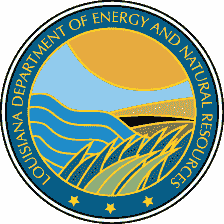Emergency Preparedness
DNR officials discuss new Federal Wetland Policy changes
 |
| DNR Coastal Management Division Assistant Administrator Jim Rives (l) and Administrator Dr. Terry Howey |
Recently, changes in federal wetland policies have been the subject of many national, state and local news articles. Primarily, the current changes in wetland policies under the Bush Administration deal with isolated wetlands and with new mitigation guidance.
Dr. Terry Howey, who serves as Administrator for the state Department of Natural Resources’ Coastal Management Division (CMD), was asked to shed light on new wetland policy and what changes might occur in Louisiana as a result. Both Dr. Howey and CMD Assistant Administrator Jim Rives have addressed the topic in an interview in the latest issue of the department’s newsletter, Coastlines. Their comments are reproduced here:
Will these changes in federal wetland policy alter the wetland regulatory authority provided by the Coastal Use Permit process?
No, the Louisiana Coastal Resources Program (LCRP) is the lead regulatory agency of the Louisiana Coastal Zone, including coastal wetlands. Because Louisiana has an approved coastal management program, the actions of federal agencies must be, to the maximum extent practicable, consistent with the LCRP. Thus, the mitigation regulations of the LCRP will not be supplanted by the new federal policies.
How does the change in federal policy on isolated wetlands affect wetland protection in the coastal zone?
It may result in loss of regulatory protection of isolated wetlands not only in the coastal zone, but everywhere else in the state. The changes in federal policy with respect to isolated wetlands are the result of a U.S. Supreme Court decision, Solid Waste Agency of Northern Cook County (SWANCC) v. United States Army Corps of Engineers. In this case, the Court ruled that Section 404(a) of the Clean Water Act did not apply to an abandoned sand and gravel pit purchased by a consortium of towns as a disposal site for nonhazardous solid waste. The site did not contain wetlands, but the Corps of Engineers determined that the site was jurisdictional because it contained “waters of the United States” since migratory birds used the site. The Court ruled that the “Migratory Bird Rule” should not be applied in cases involving isolated, nonnavigable, intrastate waters that are not tributary or (in the case of wetlands) adjacent to navigable waters or tributaries. This court decision is considered an important precedent which has application to all isolated waters and wetlands previously regulated by the Corps of Engineers under the Migratory Bird Rule.
The State and Local Coastal Resources Management Act of 1978 (SLCRMA) does not provide for regulation of most activities in isolated wetlands because only activities which affect coastal waters are jurisdictional. The SLCRMA provides that activities in areas isolated from coastal waters, including wetlands, are not jurisdictional unless the impacts of those activities extend into coastal waters. Further, SLCRMA provides that activities which occur in areas five feet above mean sea level or higher, including wetlands, are not jurisdictional. However, activities in certain types of upland habitats such as cheniers, salt domes, sand dunes, and similar geographic land forms, even those at or above five feet above mean sea level, are jurisdictional under SLCRMA. To summarize, the LCRP never had authority to regulate activities in isolated wetlands (except as noted above), and changes in federal wetland policy will not change that. So, if federal regulation of isolated wetlands in the coastal zone ceases, activities in those wetlands will not be subject to any regulation other than local zoning and permitting. Further, since Louisiana has no state-wide wetland regulatory authority, isolated wetlands outside the coastal zone will also be unregulated.
Some state governments, notably Wisconsin, quickly reacted to the potential loss of wetland protection by passing laws to directly regulate isolated wetlands. Information concerning this issue can be found at: www.epa.gov/owow/wetlands/swanccnav.html
How does the new federal guidance on mitigation affect mitigation in the coastal zone?
On December 24, 2002 the U.S. Army Corps of Engineers issued the Regulatory Guidance Letter on Compensatory Mitigation Projects for Aquatic Resource Impacts Under the Corps Regulatory Program. The guidance letter may be accessed at: www.usace.army.mil/inet/functions/cw/hot_topics/RGL_02-2.pdf
The changes proposed in the guidance letter will have little or no effect on activities in coastal wetlands, but they may have an effect on activities in areas subject only to federal jurisdiction. The “mitigation authority” of the Louisiana Coastal Management Division and approved local programs is based on state law, not federal law, so changes in federal policy will not affect activities subject to LCRP permitting. However as discussed above, the Corps of Engineers is the sole regulatory agency over isolated wetlands in or out of the coastal zone, so the changes in mitigation policy are tied up with the isolated wetland issue to some extent. Basically, if the Corps does not regulate isolated wetlands due to policy changes, it will be unable to require mitigation for those isolated wetlands if they are altered by development activities.
At present, it appears that Louisiana’s coastal management and restoration efforts will be relatively unaffected by the proposed changes in federal wetland policy and that the local/state/federal alliance to protect and restore our coastal wetlands will continue unabated.
Editors: For more information on this news feature, contact the Louisiana Department of Natural Resources’ Public Information Office at 225-342-8955 or CMD Administrator Dr. Terry Howey at 225- 342-5007.
News Archives »